“Gun violence” is a polarizing term because it often includes incidents where no individual was threatened or harmed. Nonetheless, the fluctuation of gun violence statistics remains a concern for many Americans.
America has more civilian-owned guns per capita than any other country in the world. However, only 0.0084% of the country’s estimated 500,000,000 firearms are used to end a human life.
“Gun violence” is a broadly defined term that encompasses the relationship between firearms and death, crime, or injuries. Unfortunately, this vague terminology can divert conversations from concrete data and hinder the development of effective solutions.
This report will highlight the increasing issues related to gun violence and provide a clearer understanding of the term.
- In the first four months of 2024, there were 5,847 firearm-related homicides, unintentional shooting deaths, and defensive use cases resulting in death, as reported by the Gun Violence Archive.
- Before May 2024, there were 10,674 firearm-related injuries reported by the Gun Violence Archive, which gathers data from 7,000 newspaper publications.
- Homicide rates in the United States dropped by 21% from 2022 to 2023, with firearm-related homicides decreasing by 25% during the same period, returning firearm-related homicide rates to pre-2020 levels at 4.7 per 100,000 people.
- Nationally, there was a 16% decrease in the total number of firearm-related deaths in 2023, with firearm-related suicides declining by 13% and firearm-related homicides dropping by 20%.
All data in this article is collected from various reputable sources. Our sources are listed here.
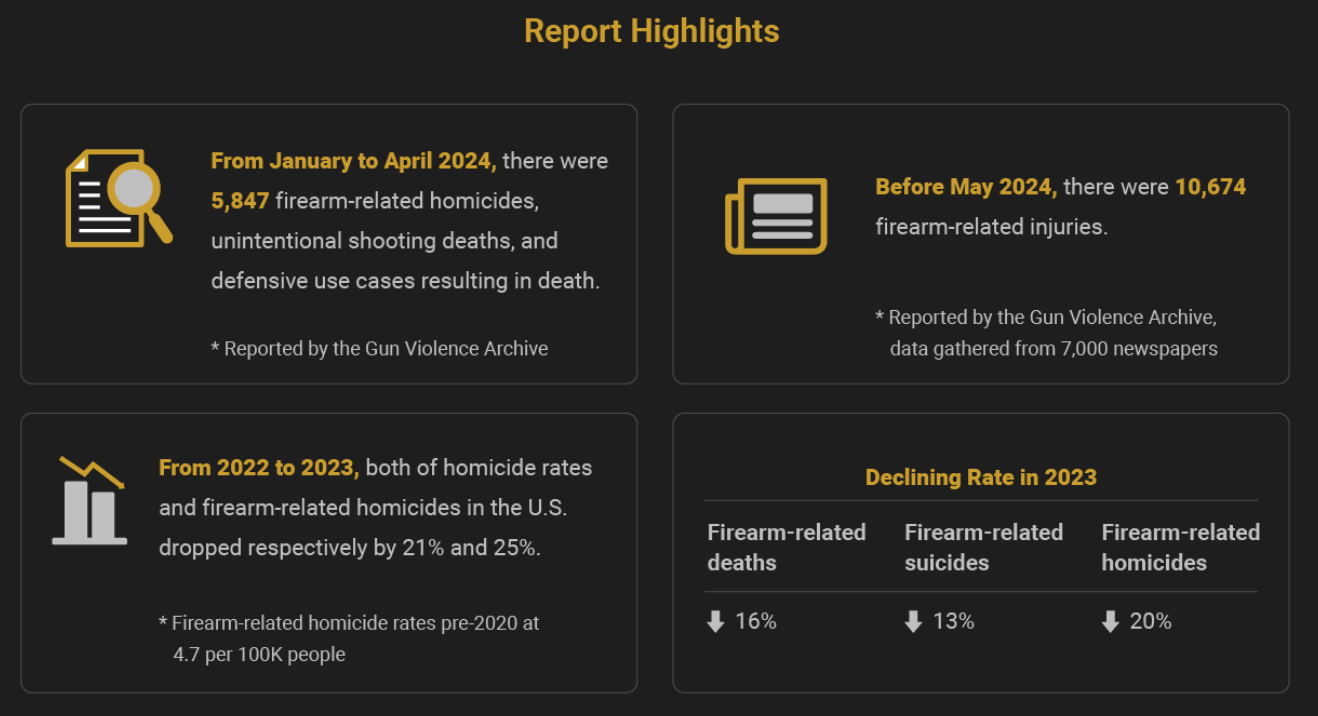
Defining Gun Violence
The term “gun violence” is controversial and often misunderstood. Before we delve into the statistics, let’s clarify how this term is used and what the public needs to know about gun-related deaths and injuries in the U.S.
Many Americans associate gun violence with a general threat. However, the media and politicians often use the term more broadly to refer to any incident involving a firearm.
For example, suicides are included in gun violence statistics, even though they pose no direct threat to others. Some reports also include cases of brandishing, which can be subjective and may involve situations where no real threat is present.
To provide a clearer picture, let’s break down firearm-related deaths and injuries in 2023:
- 58% of firearm-related deaths were suicides
- 38% were homicides
- 3% involved police shootings, accidental shootings, or were undetermined
In the following sections, we will use specific terms to accurately describe the intent behind firearm-related incidents, helping our readers better understand the impact of firearms on injuries and deaths.
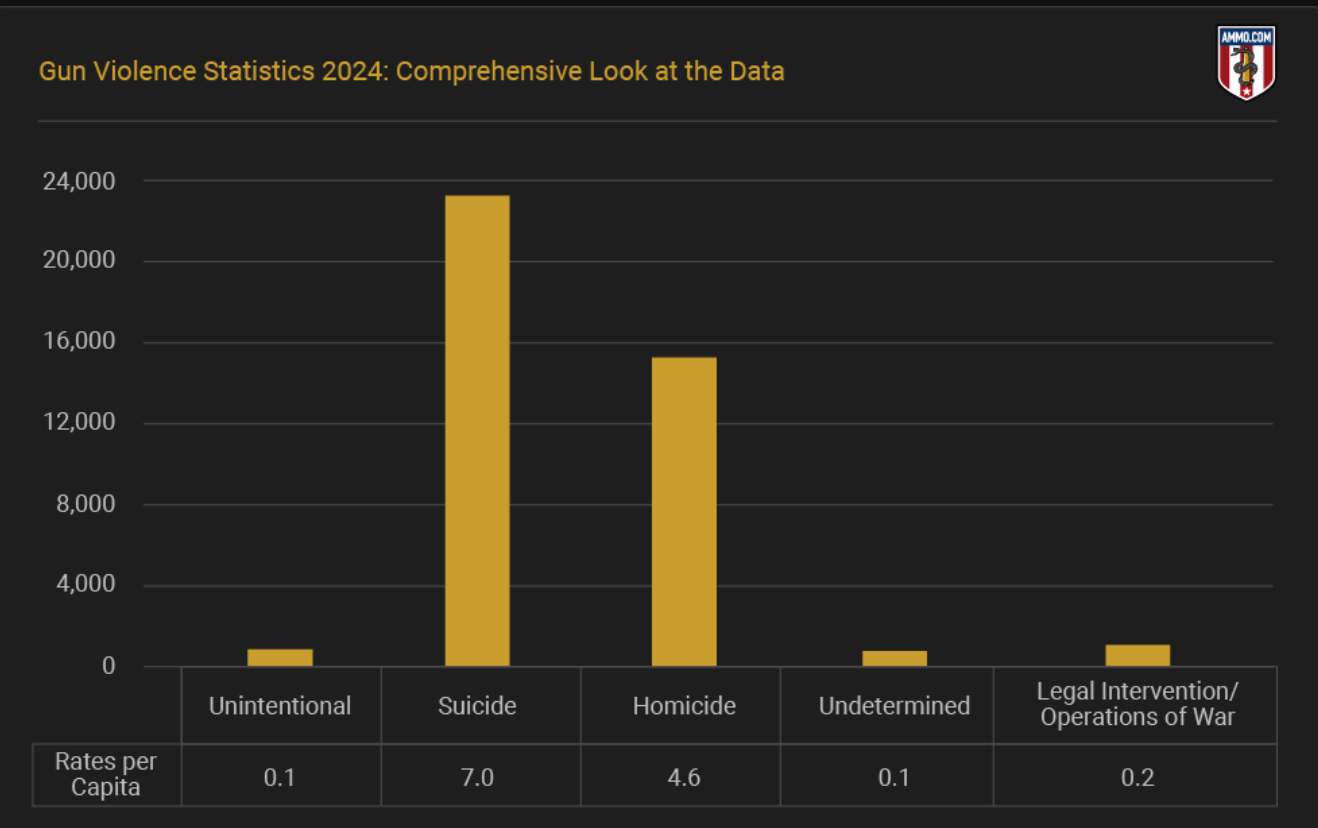
Gun Violence Statistics in 2024
According to data from the Gun Violence Archive, there were 5,847 firearm-related homicides, unintentional shooting deaths, and defensive use cases resulting in death in the first four months of 2024. Additionally, this source, which gathers information from 7,000 newspaper publications, reported 10,674 firearm-related injuries before May 2024. (Source 1)
Examining shooting incidents in early 2024 can help identify future trends when compared to previous years. For instance, if the Gun Violence Archive’s data is accurate, the 5,847 firearm-related deaths between January and April 2024 represent a significant decrease.
In contrast, the first four months of 2018 saw over 13,000 firearm-related deaths, with this number increasing to a peak of 15,572 deaths by April 2022.
Furthermore, after a sharp rise in firearm-related deaths during 2020 and 2021, the numbers have started to trend downward.
Gun Violence and Gun Ownership Statistics
Wyoming has more firearms per capita than any other state, with 245.8 per 1,000 people. In 2023, Wyoming had 107 firearm-related deaths, of which 89% were suicides and 9% were homicides.
In contrast, New Jersey has the fewest firearms per capita, with 1.1 per 1,000 people, yet 337 people died from gun-related incidents in 2023. Only 31% of these deaths were suicides, highlighting a stark difference from Wyoming.
Thus, by the definition of gun violence, New Jersey, with fewer firearms, experiences more gun violence.
The United States experienced 40,627 firearm-related deaths in 2023. Of these, 59% were suicides, 38% were homicides, and 3% were due to legal intervention, unintentional shootings, and undetermined causes.
Examining gun-related deaths further reveals that states with higher gun ownership have a lower percentage of firearm-related homicides. Conversely, states with fewer guns have a higher proportion of homicides in their gun death totals.
For instance, only 16.7% of Maryland residents own firearms, yet 80% of the state’s gun deaths are homicides. On the other hand, 65.7% of Montana residents own firearms, and only 19.3% of gun deaths are homicides.
Regarding suicides, higher gun ownership states tend to have a greater proportion of firearm-related suicides within their total gun deaths, although gun ownership does not directly influence overall suicide rates.
Ultimately, the data indicates that firearm ownership does not necessarily lead to more gun violence, homicides, or suicides. Instead, it suggests that the availability of firearms may influence the method of suicide but not the overall suicide rates.
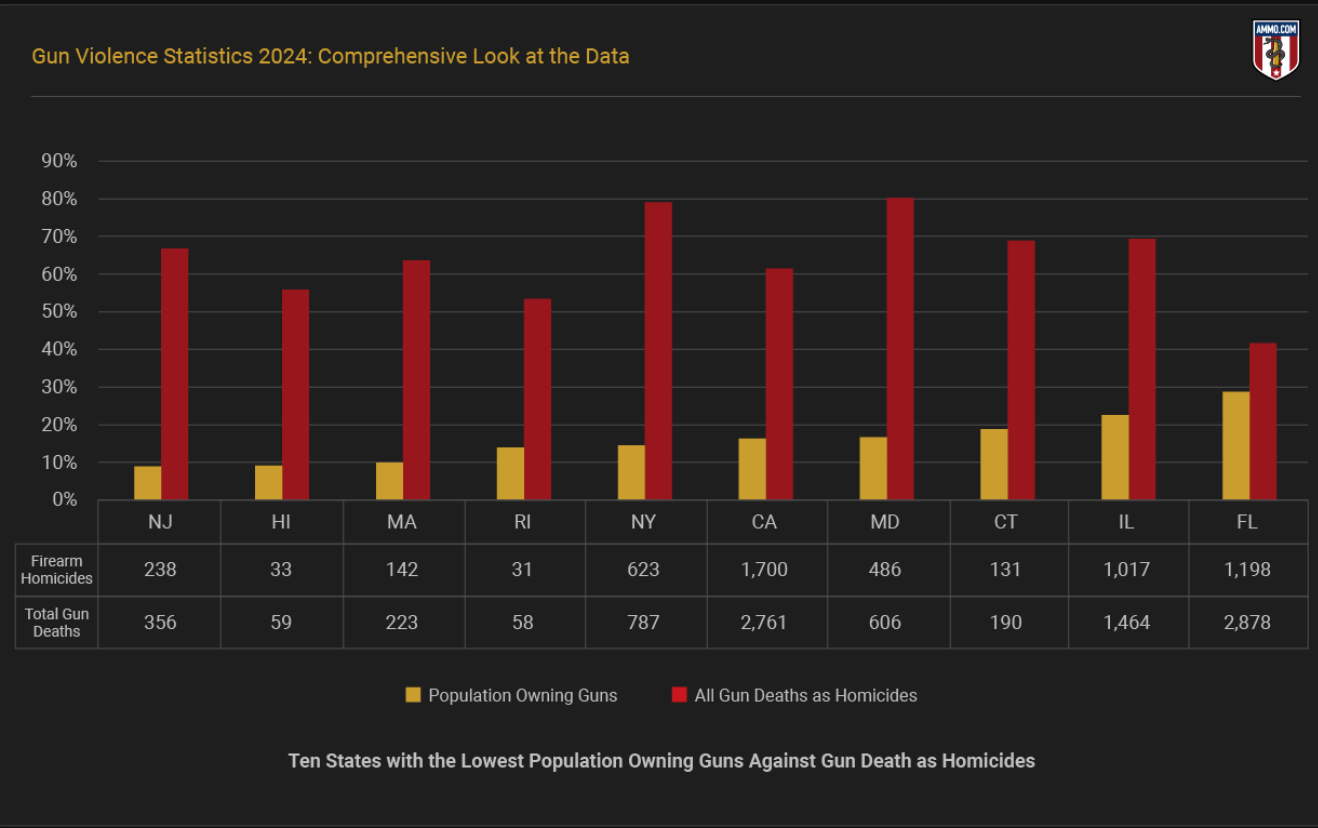
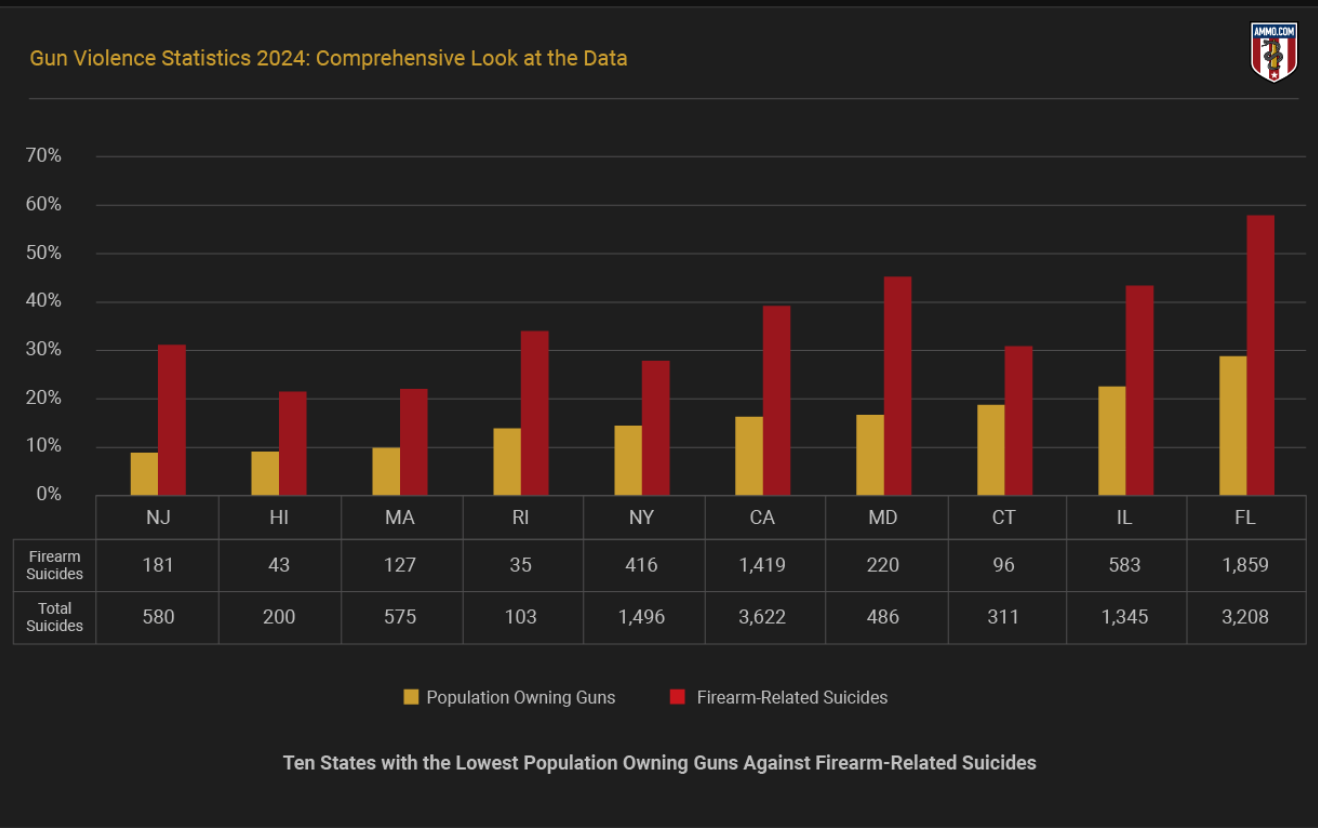
Gun Violence Deaths by Year in the U.S.
Homicide rates in the United States dropped by 21% from 2022 to 2023, with firearm-related homicides decreasing by 25% during the same period. As a result, firearm-related homicide rates returned to pre-2020 levels at 4.7 per 100,000 people.
Nationally, there was a 16% decrease in the total number of firearm-related deaths. Firearm-related suicides declined by 13%, while firearm-related homicides dropped by 20%. In 2023, 78% of all homicides were committed with a firearm, compared to 79% in 2022.
Despite 56 consecutive months of over 1,000,000 firearm sales in the U.S., gun violence appears to be returning to lower levels.
Non-Fatal Gun Violence in the U.S.
In 2021, 1,958,273 individuals visited an emergency room for an injury related to violence. According to the FBI NIBRS, in 2022, 231,878 of the 815,580 violent crimes reported involved a firearm. (Source 5)
Tracking firearm-related injuries from violence is challenging. For example, the CDC WISQARS compiles data on the number of ER visits but doesn’t specify the nature of the injuries. The FBI UCR collects crime report data, but not all incidents involving firearms are classified as violent.
A study estimates the average number of non-fatal firearm-related emergency room visits to be 84,581 incidents per year from 2010 to 2015 (Source 3). However, in 2020, the number of ER visits for firearm-related injuries increased by 37%, while other injury-related visits decreased. This trend continued with a 36% increase in 2021, but firearm-related ER visits declined by 20% in 2022. (Source 4)
Similar to homicide rates, firearm-related injuries and violent crimes increased during the pandemic but have declined since 2022. Despite millions of gun sales, the passage of permitless carry legislation in several states, and soft-on-crime policies, the threat of non-fatal gun violence has been trending downward as of 2023.
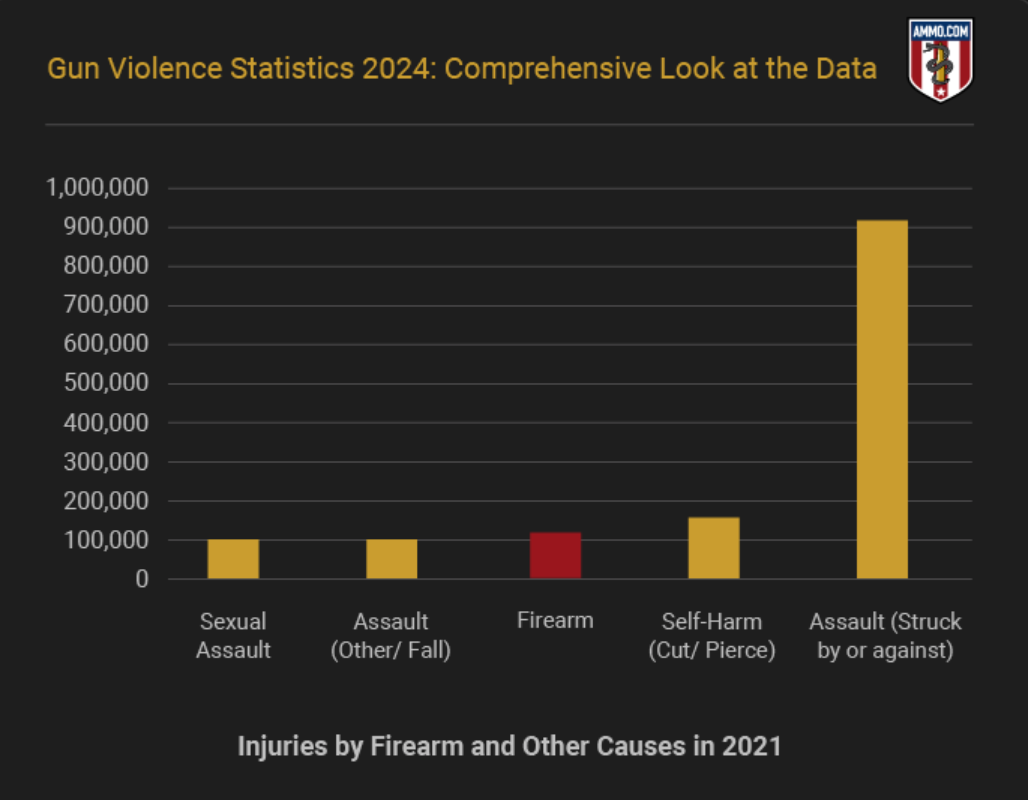
Gun Violence by Demographics
While race does not cause gun violence, there is a significant correlation between the race of victims and higher rates of gun violence. For example, Black Americans, Hispanics, and Native Americans are 70% more likely to be victims of gun violence than other demographics. (Source 2)
Gun violence, particularly assaults with firearms, is a complex issue influenced by various factors, including inner-city violence, reduced policing, lower incarceration rates, and soft-on-crime policies.
In 2022, Black Americans were killed with guns at a rate of 20 per 100,000. For Hispanics, the rate was 4.4 per 100,000, and for Native Americans, it was 4.3 per 100,000. In contrast, Asian and White Americans had rates of 0.9 and 1.6 per 100,000, respectively.
The pattern changes only slightly when excluding firearms: White Americans were killed at a rate of 0.8 per 100,000, Hispanics at 1.4 per 100,000, Native Americans at 4.5 per 100,000, and Black Americans at 3.4 per 100,000.
The reasons why Black Americans, Native Americans, and Hispanic Americans are more likely to be victims of gun violence are not fully understood, but the data clearly shows severe racial disparities in violence-related victimhood in the United States.
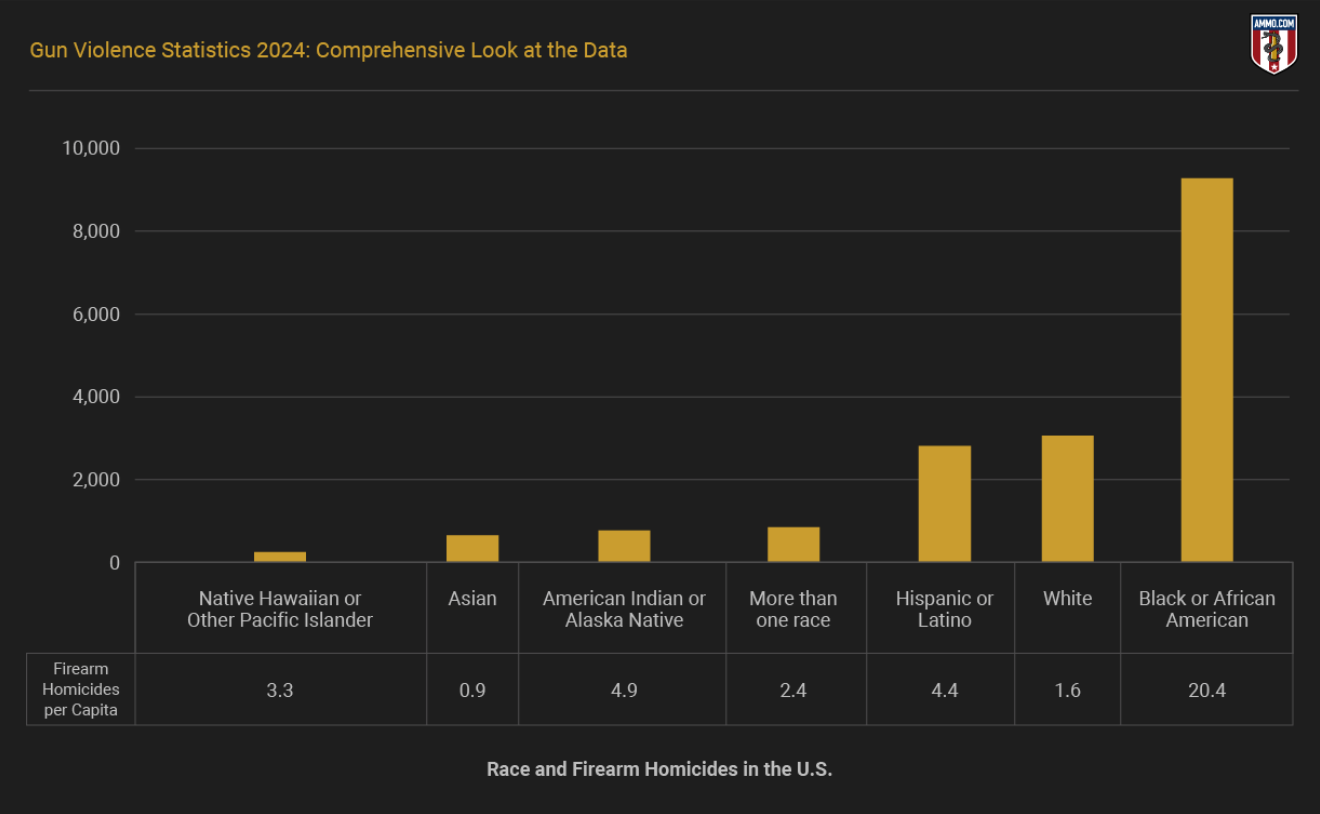
Trends and Decline: Navigating the Fluctuations of Gun Violence in 2024
“Gun violence” is a polarizing term because it often includes incidents where no individual was threatened or harmed. Nonetheless, the fluctuation of gun violence statistics remains a concern for many Americans.
Gun violence rates increased in the 1960s, peaked in the 1980s, decreased in the 1990s, and rose again during the COVID-19 pandemic. Fortunately, gun violence statistics in 2024 indicate that this problem is now declining.
Sources:
- Gun Violence Archive: 2024
- CDC Wonder Provisional Mortality Statistics
- A Cross-Sectional Study of Firearm-Related Injuries in Emergency Department Patients
- Emergency Department Visits for Firearm Injuries Before and During the COVID-19 Pandemic — United States, January 2019–December 2022
- 10 Leading Causes of Nonfatal Emergency Department Visits, United States
LegalReader thanks our friends at Ammo.com for permission to republish this piece. The original is found here.


Join the conversation!